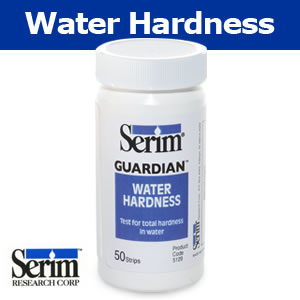
GUARDIAN™ WATER HARDNESS TEST STRIPS
Serim® GUARDIAN™ Water Hardness Test Strips give a semi-quantitative indication of the level of hardness in water. Hardness is used to describe the total concentration of calcium and magnesium ions, expressed as ppm (or grains per gallon) of calcium carbonate, CaCO3.
Hard water can adversely affect the dialysis patient as well as damage the
water purification equipment. In general,
water treatment system manufacturers
recommend that the hardness of water
entering the RO filter should no exceed 10 ppm of calcium carbonate1.
AAMI Guidelines set the maximum concentration in final product water at 2 ppm for calcium and 4 ppm magnesium.2
Water used in hemodialysis should be monitored closely for hardness.3
- Product Profile
- Product Uses
- How To Use
- Product
| SERIM GUARDIAN WATER HARDNESS TEST STRIPS | |
| Features | Benefits |
| Greater sensitivity than most other water hardness test strips |
|
| Simple "Dip & Read" procedure |
|
| Quick, semi-quantitative results in 10 seconds |
|
| Ready-to-use strips |
|
| Product performance is not affected by high levels of common water contaminants |
|
| Consistent color reactions |
|
| Simple to interpret color blocks labeled as "parts per million" (ppm) and equivalent "grains per gallon" (gpg) |
|
| Each bottle clearly labeled with: • Lot number • Expiration date |
|
| Test strip can be immersed into sample or held in sample stream |
|
1. NANT Dialysis Technology – A Manual for Dialysis Technicians, 2nd Edition (2000), pg. 109. National Association of Nephrology Technicians/ Technologists, Dayton, OH
2. AAMI Standards and Recommended Practices, Dialysis, 2008 Edition, RD62 - Water treatment equipment for hemodialysis applications. Association for the Advancement of Medical Instrumentation, Arlington, Virginia
3. NANT Dialysis Technology – A Manual for Dialysis Technicians, 2nd Edition. (2000) pp 102-103. National Association of Nephrology Technicians/ Technologists, Dayton, OH
WHAT does this product do?
Serim® GUARDIAN™ Water Hardness Test Strips give a semi-quantitative indication of the level of hardness in water. Hardness is used to describe the total concentration of calcium and magnesium ions, expressed as ppm (or grains per gallon) of calcium carbonate, CaCO.
WHY should I use this product?
Hard water can adversely affect the dialysis patient as well as damage the
water purification equipment. In general,
water treatment system manufacturers
recommend that the hardness of water
entering the RO filter should not exceed
10 ppm of calcium carbonate1.
AAMI Guidelines set the maximum concentration in final product water at 2 ppm for calcium and 4 ppm magnesium.2
WHERE do I use this product?
Test a sample of water at the post-softener stage of the water treatment process to make sure that the softener is removing calcium and magnesium.
WHEN do I use this product?
Daily. Water used in hemodialysis should be monitored closely for hardness.3
References:
1. NANT Dialysis Technology – A Manual for Dialysis Technicians, 2nd Edition (2000), pg. 109. National Association of Nephrology Technicians/ Technologists, Dayton, OH
2. AAMI Standards and Recommended Practices, Dialysis, 2008 Edition, RD62 - Water treatment equipment for hemodialysis applications. Association for the Advancement of Medical Instrumentation, Arlington, Virginia
3. NANT Dialysis Technology – A Manual for Dialysis Technicians, 2nd Edition. (2000) pp 102-103. National Association of Nephrology Technicians/ Technologists, Dayton, OH
| Test Method | Immersion | Stream |
| Sample | Collect water sample in a clean container. | Open valve and allow water to run out in a slow, steady stream. |
| Test Strip Technique | Immerse indicator pad into water sample for 1 second. | Insert indicator pad into stream of water for 1 second. |
| Results | Compare the color of the indicator pad to the color blocks on the bottle label 10 seconds after immersion of the pad. | Immediately compare the color of the indicator pad to the color blocks on the bottle label. |
| Store bottles of Serim GUARDIAN Water Hardness Test Strips at temperatures between 15°- 30°C (59°- 86°F). The lot number and expiration date are printed on the bottom of each bottle. |
||
References:
1. NANT Dialysis Technology – A Manual for Dialysis Technicians, 2nd Edition (2000), pg. 109. National Association of Nephrology Technicians/ Technologists, Dayton, OH
2. AAMI Standards and Recommended Practices, Dialysis, 2008 Edition, RD62 - Water treatment equipment for hemodialysis applications. Association for the Advancement of Medical Instrumentation, Arlington, Virginia
3. NANT Dialysis Technology – A Manual for Dialysis Technicians, 2nd Edition. (2000) pp 102-103. National Association of Nephrology Technicians/ Technologists, Dayton, OH
 |
GUARDIAN™ WATER HARDNESS TEST STRIPS | |||
| Product | Description | Packaging | ||
| 5129 | Water Hardness Test Strips | 6 Bottles of 50 Test Strips / Kit | ||
